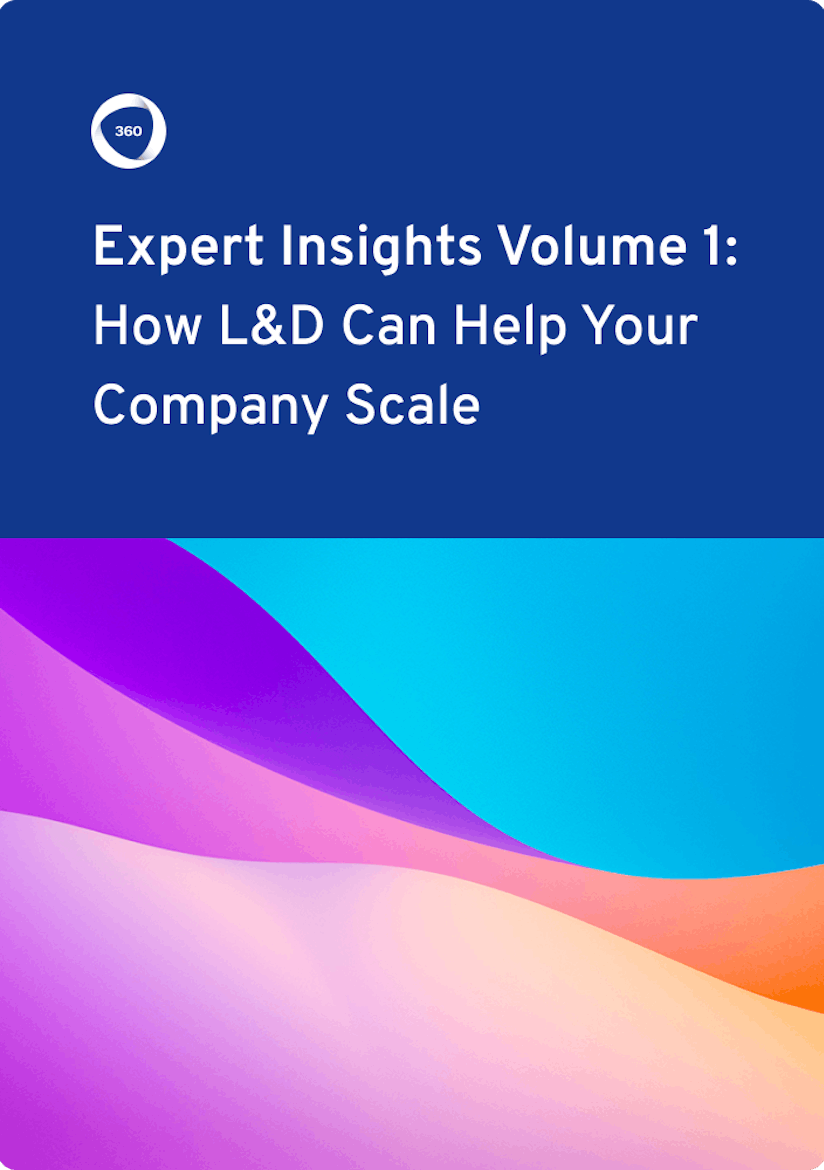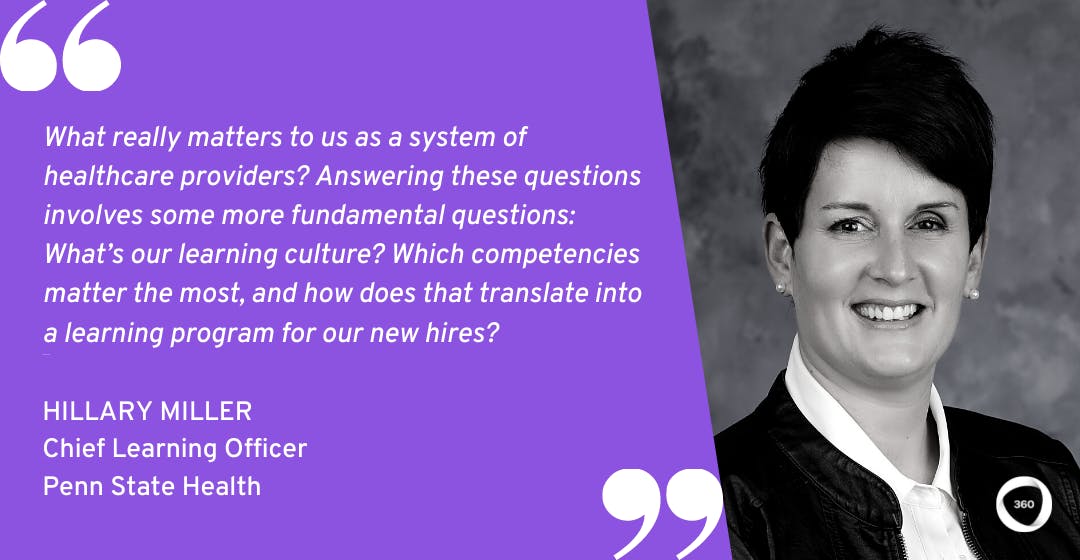When organizations are going through a process of transformation and change, L&D leaders have a crucial role to play. This is especially true for healthcare outfits across the US, many of which are now growing into multi-organization healthcare systems.
So, how can L&D teams build dynamic learning programs that facilitate collaboration within these changing organizations? And how can they create learning experiences for new hires that help people make the best start within a growing healthcare system?
In my fifth and final interview as part of our healthcare L&D mini-series, I spoke to Hillary Miller, Chief Learning Officer at Penn State Health, about her four-step strategy for building experienced-based learning programs to onboard new hires into a growing system of healthcare organizations.
Hillary had a great deal of expertise and knowledge to share–read on to get energized!
Loving what you’re reading? Come and join the L&D Collective for more great learning insights, resources, and events!
Great L&D starts with assessing your organizational landscape
Hillary set the stage by describing a priority the L&D team at Penn State Health is embarking upon as a growing player in the health care sector.
“My role was created to come in and figure out how we bring our different teams together in creating great learning experiences,” she says. “We’re in a highly transformative state, and we have all the hospitals that have an outstanding reputation for academic medicine and community partnerships.”
“And so, that’s really the priority for me this year: to assess and scan across our organizational landscape, and to examine how we partner our teams and bring learning together.”
So, where does Hillary start with undertaking this exercise and bringing her teams together across Penn State Health’s different organizations? As she explains, she uses a four-step strategy to build new hire learning experiences that put experience at the heart of learning.
Need a few more CLO Connect expert insights? Find out how WhatsApp, Klaviyo, Amazon, and other market leaders are scaling their organizations with the right L&D strategy.

You have questions–the experts have the answers
By providing your contact info, you agree to receive communications from 360Learning. You can opt-out at any time. For details, refer to our Privacy Policy.
That’s really the priority for me this year: to assess and scan across our organizational landscape, and to examine how we partner our teams and bring learning together.
Penn State Health’s 4 steps to experience-based learning for new hires
With the L&D team’s priority set, it was time for them to bring learning together through their academic medicine and community partnership teams.
As she explains, Hillary launched her strategy by consulting extensively with her stakeholders.
1. Initiate a listening tour to build your understanding of the status quo
First, when Hillary began her role, she started with a listening tour and engaged with the people within the organization.
“Who are the people?” she asks. “Where do they sit, and what do they do? I was just asking questions. It wasn't a question of coming up with a plan initially, it was just to understand where we are today from the perspectives of the people who are key stakeholders.”
This listening tour helped Hillary to develop a deeper sense of the learning challenges involved with Penn State Health’s organizational transformation, and more specifically, how to address these challenges with the right mix of new hire learning.
2. Determine your foundational learning theme
With the listening tour completed, Hillary was able to identify priority learning areas and develop a foundational theme around them.
“So, I went with ‘the entry’ as my theme,” Hillary explains. “How are we bringing people into the organization? What is their experience with new hires? And how are we connecting our new hires around clinical rotations? How are we welcoming them into our system?”
“All of those organizational experience-based activities give us a good solid foundation around the things we are able to do to help people make the right start within our organization. Why do they want to come work for us?”
Related: The 360Learning Onboarding Playbook
3. Decide which learning competencies matter most
Subsequently, these exercises placed Hillary in a great position to decide which learning competencies matter most, and design learning programs that correspond to these priorities.
“What are the activities happening at the hospital? And beyond that, what really matters to us as a system of healthcare providers? Answering these questions involves some more fundamental questions: What’s our learning culture? Which competencies matter the most, and how does that translate into a learning program for our new hires?”

4. Tailor your approach to suit new hires and new leaders
Finally, as Hillary explains, they identified two different audiences in the theme of new hire experience: new hires and new leaders.
“We’re catering to different learning needs,” she says. “For example, we have new people coming into the organization as individual contributors, but we also have new leaders coming on board as well. We need to help them understand how to lead, and what’s happening within the wider organization.”
“So these experience-based entry programs set the stage for other learning and development activities that we’re going to offer in the future.”
Penn State Health’s experienced-based strategy for new hire learning emphasizes how collaborative learning can be a big asset to all healthcare organizations. By creating learning programs tailored to the specific needs of new hires and new leaders, Hillary and her team can engage new hires with the learning they really need to be welcomed into Penn State Health’s growing network of healthcare organizations.
Related: Leaders Are Learners, Too: 5 Ways L&D Teams Can Support Leadership Development
These experience-based entry programs set the stage for other learning and development activities that we’re going to offer in the future.
Measuring the success of Penn State Heath’s experienced-based strategy
So, with this four-step strategy for building experienced-based new hire programs underway, how do Hillary and the L&D team know that they’re creating a positive onboarding and ramp-up experience?
“We started with an engagement survey,” she says. “That is something where we’re getting a holistic view of how people feel about the organization as a whole, and learning is a big component of that.”
“Another piece involves working with the key stakeholders and understanding the new hire experience during the first 90 days. We’re setting decision criteria to understand what really matters during this crucial first few months, and how we can be sure we’re creating the right experience.”
According to Hillary, this assessment goes beyond just the initial new hire experience to look at how things evolve beyond their first weeks and months.
“We’re looking at whether our new hire experience turns into something that is positive, or whether things change after their first few months,” she says. “Are we finding that people are saying they felt ready to go in their first 60 days, but that now they’ve been here 6 months, they’re starting to feel a little bit of the pressure, and their experience has changed? If so, we need to do something about that.”
At the same time, Hillary is also examining her measurement approach within learning in general. “It’s bigger than just looking at the volume of learning, and it’s bigger than tracking how many people we have coming from different departments. This is all important information, but it doesn't really tell us about their experience.”
“Instead, we have to connect this information through informal and formal ways. Some of that is through an interview group, or connecting with the manager who had somebody new come in recently. We’re building a holistic view of the learning impact.”
Related: 3 Data-Based Ways to Prove Training ROI (+ Free Training ROI Calculator)
We’re looking at whether our new hire experience turns into something that is positive, or whether things change after their first few months.
Our biggest thanks to Hillary for sharing her experienced-based strategy with us!
Get inspired by last week’s healthcare L&D interview with Judy Zola of Boston Children’s Hospital about combating burnout with learning opportunities, and Sarah Larson of the Stanford University School of Medicine on their leadership education program.
Want more peer insights on transforming workplace learning? Sign up to become a member of the L&D Collective, and check out our other #CLOConnect interviews with top L&D leaders on driving growth and scaling culture through collaborative learning. Or you can subscribe (below 👇) to our weekly newsletter to receive our latest posts directly in your inbox.


